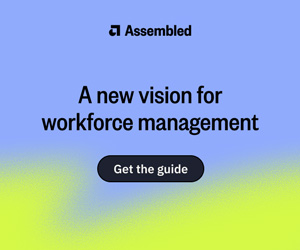Delivering an amazing customer support strategy doesn’t happen by chance!
That’s why we asked Afshan Kinder, thought leader and co-author of three books – including ‘Call Center for Dummies’ – to explain how to take the lead on building a customer support strategy that creates truly exceptional customer experiences.
Here’s what she said…
What Is a Customer Support Strategy?
A customer support strategy (also known as a customer support system) is built intentionally with technology, processes, and people, all working together to deliver an exceptional customer experience.
The goal is to efficiently resolve a customer’s enquiry or request in a single contact, across all channels – whether it’s phone calls, emails, live chat, social media, and in the various languages offered.
This approach holds true for both everyday service and unexpected challenging events, aiming to achieve a long-term vision of building lasting customer loyalty and reducing customer attrition.
Let’s not forget that it also leads to profitability through word-of-mouth referrals and a greater share of wallet from existing customers.
5 Steps to Building a Great Customer Support Strategy
Let’s get started with a few key steps…
1. Decide Who Will Be in Charge of Your Customer Support Strategy
Put in place a small but mighty squad to design and maintain your customer support strategy. To ensure targeted focus and consistency of service delivery across all channels, there must be an orchestra leader.
Customer support strategies need to be continually evaluated with recommendations for future improvements.
This can only be done if the orchestra leader is in this position full-time. In today’s rapidly evolving landscape, especially with the advent of AI, having such a role is more important than ever.
Role clarity alone is not the answer. Each function must clearly know and agree to specific deliverables and must have a healthy percentage of their bonus allocated towards fixing current customer issues and implementing advancements.
Typical squad members include representation from Operations (team members, team leaders, managers), QA, Training, Workforce, Marketing, IT, your technology partners, and, very importantly, Finance.
Keep Finance as your ally and right hand in building your business cases as they can determine your baseline costs.
Once a baseline is established, it becomes easier to measure process improvements and the impact of technology. It is also a great way to measure the impact of people-based solutions such as revenue generation in customer interactions.
2. Map Out the Key Customer Experience Journeys
The orchestra leader facilitates thought leadership and mapping for each key customer journey and leverages common best practices across all journeys.
So, now that you have an individual leading the charge, start mapping out key customer experience journeys and calculate the total cost of each high-frequency interaction in each journey.
The cost must include the total time based on the number of interactions between a customer and a customer-facing team member. Don’t forget to include the cost of back-office team members.
If you are looking for ways to improve your customer journey mapping, read our article: How to Improve Your Customer Journey Mapping
3. Rank Each Customer and Team Member Touchpoint
Once customer journeys are mapped, focus on “the art of the possible”.
Start by ranking each key customer and team member touchpoint by prioritizing highest cost per interaction. Typically, high-cost transactions are ones that have the highest customer and team member effort.
You might think, “Wow, this seems like a huge task.” Don’t get bogged down in data analysis. Since this step is directional, estimate the numbers using available data and informed guesses.
4. Address Specific Service Failures
Now that you have red-circled specific service failures, below are some remedies:
Eliminate Service Failures and Requests
The best service is one that is not needed. Make the interaction with your company easy for customers. Don’t give them a reason to contact you.
Not sure where to start? For the classic broken processes to look out for, signs to spot them, and best advice on how to fix them, read our article: Key Signs of Broken Processes (and How to Fix Them)
Create High Containment Within Self-Service Channels
Well-designed self-service options result in high containment in that channel. Measure containment rates by enquiry or transaction, aiming for at least 50%. That is, 50% of customers in that self-service channel do not need human intervention. This is a good starting goal, knowing that ongoing improvements will lead to higher containment.
The best way to keep customers contained in that channel is to reduce the steps or clicks needed to find information or complete a transaction.
Want to improve your self-service offerings? Read our article: Ideas to Improve Customer Self-Service
Minimize Hand-Offs
With AI on your doorstep, your team members will be resolving situations that are complex and messy.
So, be sure to empower frontline team members with the authority and tools to resolve issues without secondary help.
For short- and long-term strategies for reducing call transfers, read our article: Need to Reduce Call Transfers? Try These Approaches
Invest in Critical Thinking and Decision-Making Skills
Now is the time to invest in building critical thinking and decision-making skills as well, not only with your customer-facing team members, but also with your first- and second-line leaders. Your leaders will need to be highly proficient in leading and coaching.
Shorten Turnaround Times
Technology is an excellent enabler, but shorter turnaround times can be designed at no cost through out-of-the-box thinking.
For example, with one e-commerce client, we changed the starting shift time of the warehouse pick and pack operation from 7am to 5am.
We were able to push more orders to our delivery company on the same day. Customers received their order the next morning, which reduced customer enquiries about order status by 60%!
5. Set High Expectations With Your Team
To ensure their contributions are truly value-add, set clear expectations with each functional group.
Outside of the traditional and expected contributions of each group, below are suggestions to raise the bar:
IT and Technology Partners
Your partners must be more than technology experts. They must add value by sharing how technology can reduce or eliminate service failure, drive higher containment in self-service channels, support endeavours to empower your team members, reduce hand-offs and shorten turnaround times.
Many companies utilize only a fraction of their purchased technology. They should be at the ready to share how existing features can be leveraged at minimal or no additional cost.
Contact centres need to make the most of their technology. For advice on the top mistakes to avoid, read our article: 3 Technology Mistakes That Are Probably Ruining Your Contact Centre
Training and Development
As they are responsible for training customer-facing team members in product knowledge, process, and all soft skills, it is important to stay current of new learning methodologies and modalities, especially in today’s virtual and hybrid environment.
What strategies is this team presenting to increase the speed of proficiency of new hires?
Does your organization have an employee development path that starts on Day 1 with quantifiable and behavioural milestones?
If you want to know the essential soft skills that every call centre agent should have, read our article: 5 Soft Skills Every Agent Needs Before Taking Their First Call
First-Line Leaders
To have a thriving customer support system, a frontline operational leader should be guided by an employee development path, actively developing their team.
As there are milestones, team members know what is expected of them, and leaders are clear on what to coach to. Having an employee development path in place creates consistency and increases speed to proficiency.
The challenge in most organizations is that first-line leaders are often preoccupied with managing crises and analysing data, and are drowning in emails and meetings.
Keeping the business afloat is necessary, but it is not what drives excellence. Best-of-breed organizations set clear expectations with first-line leaders that they should spend at least 50% of their time developing their team members.
For advice on what to look for in your leadership and how to develop these traits, read our article: 9 Traits of High-Performing Team Leaders
Senior Operational Leaders
A customer support strategy must be measurable. When there are too many metrics, such as First Contact Resolution and C-SAT Scores in play, it can be confusing.
It’s the job of senior leaders to ensure that their teams are clear on what is the most important. They can do this by communicating at least one primary measure or North Star KPI and holding their teams accountable to achieve this measure.
Escalation Team
Aside from establishing clear escalation procedures for handling complex or unresolved issues, set expectations with an escalation team to identify strategies to reduce customer escalations.
What is the support strategy to drive greater skill and empowerment for frontline team members?
For advice on creating an escalation matrix, read our article: How to Design an Escalation Matrix for Call Centre Agents
Quality Assurance
QA programs are often focused on assessing the customer experience or assuring that agents adhere to service standards to maintain high-quality interactions with customers.
Future changes to a customer support system cannot be made solely based on data. Understanding the specificity of the challenge for customers completes the picture.
Set expectations with QA to regularly provide this level of insight by conducting deep dives.
If you want to know how you can optimize your QA strategy while improving motivation, ensuring compliance and enhancing your quality KPIs, read our article: Call Centre Quality Assurance: How to Create an Excellent QA Programme
And… Why Is It So Important to Get This Right?
Did you know that 86% of customers are willing to pay more for a better customer experience?
Interestingly, this point really hit home for me recently when I was double-billed for my phone service. Annoying, yes, but I thought it would be simple to rectify. I figured I would just call in, get it reversed, and be done with it.
However, it turned out to be far from simple. My double-billing wasn’t an isolated incident but part of a larger issue affecting many customers. After what seemed like an eternity waiting to be served, I opted to use the IVR feature to leave my phone number for a callback.
Unfortunately, no one ever called back. Hoping for a quicker resolution, I turned to the company’s chatbot. However, the chatbot couldn’t assist, and a human representative wasn’t available either.
Frustrated, I eventually gave up on resolving my issue, assuming the company was aware of the error and had taken steps to address it.
I expected to receive some form of communication with an apology and a resolution. I never received any communication, and months later, I saw a reversal of the extra charges on my statement.
From a customer’s perspective, this experience was frustrating and disappointing. Would I have been agreeable to slightly higher fees for a one and done approach? Absolutely. Time is something we can’t get back.

If we choose to pull back the curtain and look behind the scenes at my phone company, what would we see?
We’d find a company lacking a robust customer support system and customer experience strategy for everyday interactions as well as unexpected challenges and events.
That’s why taking a proactive approach to building a customer support strategy is so important!
Written by: Afshan Kinder, thought leader and co-author of three books – including ‘Call Center for Dummies’
To learn more about developing your contact centre strategies, read these articles next:
- An Introduction to… Customer Access Strategy
- Improve Your CX Strategy – Clever Ideas From Bupa’s Contact Centre!
- Customer Service Feedback: How to Perfect Your Strategy
Author: Afshan Kinder
Reviewed by: Megan Jones
Published On: 24th Sep 2024 - Last modified: 12th Nov 2025
Read more about - Customer Service Strategy, Afshan Kinder, Customer Experience (CX), Customer Service, Service Strategy, Top Story











































